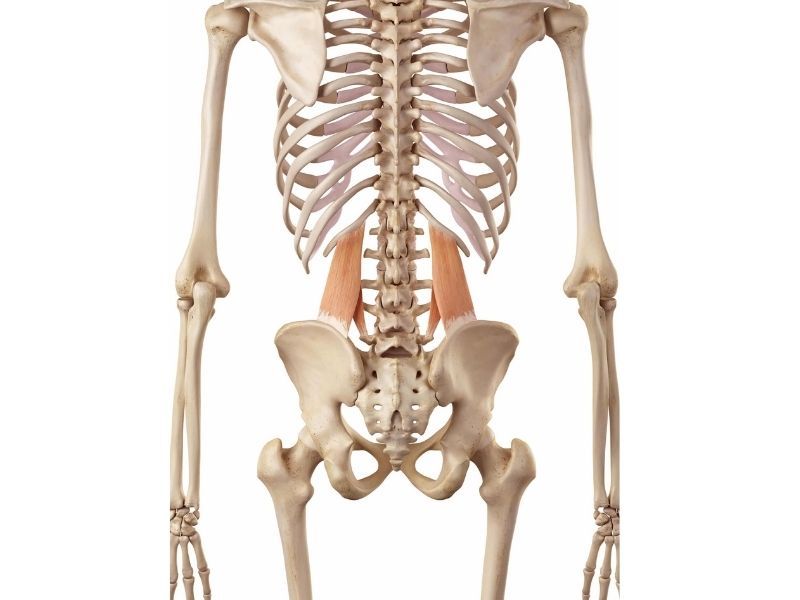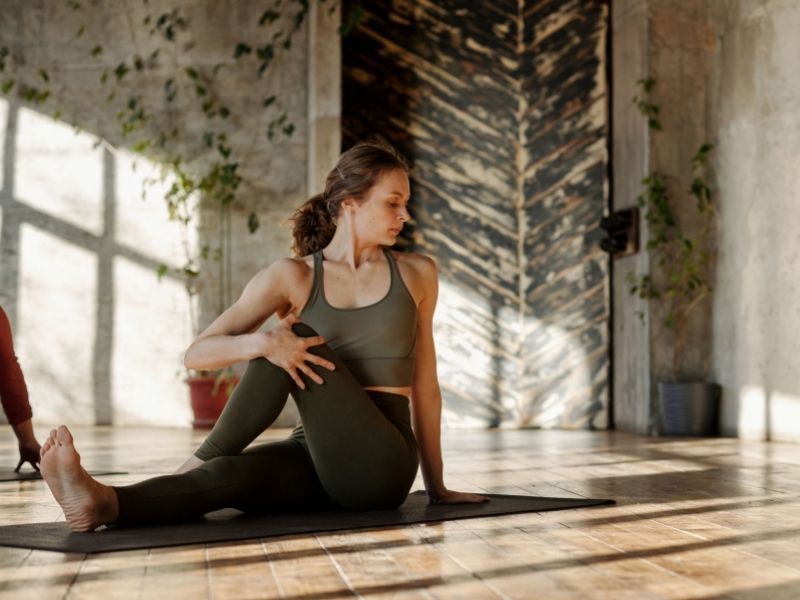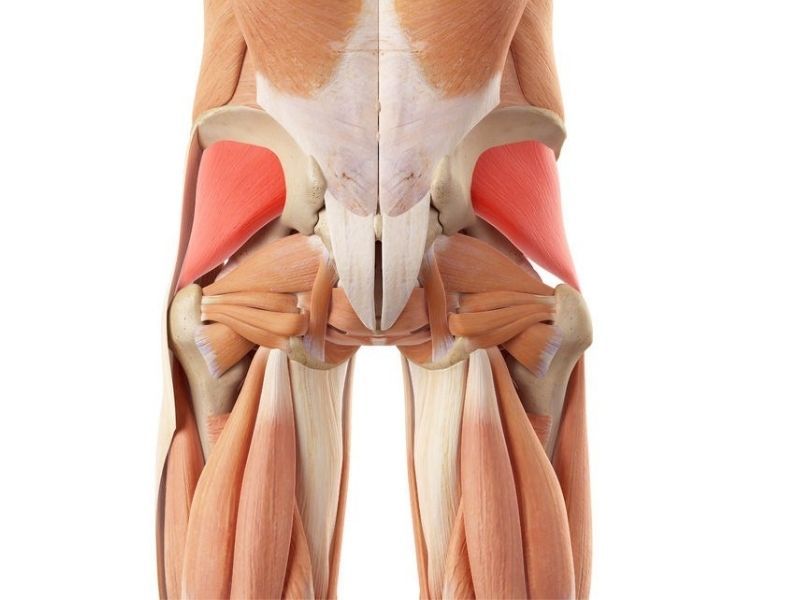Unlocking the Secrets of Quadratus Lumborum Stretches: A Comprehensive Guide to a Pain-Free Back

Table of Contents
- - The Quadratus Lumborum: Anatomy and Function
- - Common QL Problems and the Benefits of Stretching
- - Top 5 Quadratus Lumborum Stretches for Optimal Relief
- - a. Modified Side Plank Stretch
- - b. Kneeling QL Stretch with Lateral Reach
- - c. Seated QL Stretch with Rotation
- - d. Supine QL Stretch with Leg Cross
- - e. Prone QL Stretch with Arm Extension
- - Complementary Exercises for a Strong and Balanced Core
- - Tips for Maintaining QL Health and Preventing Future Pain
- - Conclusion
The Quadratus Lumborum (QL) muscle is a small yet crucial muscle located in the lower back.
This muscle plays a crucial role in maintaining back health by stabilizing the spine and pelvis during movement, as well as assisting with breathing.
However, it’s often overlooked, leading to issues such as lower back and hip pain, and discomfort.
Back pain may limit social activities. The proportion of adults with back pain reporting any limitations related to social, recreational, or family activities is more than three times the proportion of adults without any such serious low back pain.
At the end of the day, the buck stops at us. While people are bound to have back and neck pain if they don’t do certain things right, we also need to actively search for proactive and active solutions.
That’s where the importance of Quadratus Lumborum stretches comes in. By targeting this muscle, you can alleviate lower back pain, improve your posture, and increase your overall mobility.
This article serves as an example of research-backed solutions to pain-free back. By the end of the article, you’d have positioned yourself in a perfect fitness routine that will save your health. So what are you waiting for?
Let’s get started…

The Quadratus Lumborum: Anatomy and Function
Understanding the anatomy and function of the QL muscle is key to maintaining back health and preventing lower back pain.
The Quadratus Lumborum (QL) muscle is a deep, thick muscle located on either side of the lumbar spine in the lower back region. It runs from the iliac crest, which is the top of tail bone underneath the hip bone, to the bottom rib and the lumbar vertebrae.
The QL muscle has a quadrangular shape with fibers that run both vertically and horizontally, which gives it a unique structure. It’s one of the largest muscles in the lower back, and its size and position make it a key muscle in maintaining back health.
One of its primary functions is lateral flexion of the spine, which means it allows you to bend forward and sideways. This movement is important for everyday activities such as twisting, bending, and reaching.
The QL muscle also plays a crucial role in stabilizing the spine and pelvis during movement. It helps to maintain proper posture and alignment, preventing excessive movement or strain on the spine.
Additionally, the QL muscle is involved in hip elevation, which means it helps lift the hip on the same side as the muscle. This movement is essential for activities such as walking, running, and jumping.
Common QL Problems and the Benefits of Stretching
The Quadratus Lumborum (QL) muscle can be susceptible to a range of issues that can cause discomfort and pain in the lower back area.
One common problem is muscle imbalances, which can occur when one side of the muscle is stronger or tighter than the other. This can lead to an uneven distribution of weight and pressure on switch sides of the spine, which can result in lower back pain.
Another common issue related to the QL muscle is trigger points, which are tight “knots” that form within the muscle fibers. These trigger points can cause “referred” pain, meaning that the pain can be felt in other areas of the body, such as the hips or thighs.
Fortunately, quadratus lumborum stretches can help to alleviate these issues and provide several benefits for overall back health.
Stretching the QL muscle helps to increase its flexibility, which can reduce muscle imbalances and prevent trigger points from forming.
Stretching the QL muscle can also help to improve posture and reduce the risk of lower back pain. Since the QL muscle is responsible for stabilizing the spine and pelvis, maintaining its flexibility and strength can improve your overall alignment.
Additionally, it can reduce pressure on the spine and alleviate pain.
Quadratus lumborum stretches can also help to improve your range of motion and increase your overall mobility.
This can be particularly beneficial for athletes or individuals who engage in physical activity regularly, as it can improve their performance and prevent injuries.
Top 5 Quadratus Lumborum Stretches for Optimal Relief
In the previous section, we explored the common problems related to the QL muscle and the importance of stretching to alleviate lower back pain and muscle imbalances.
Now, we will guide you through five effective Quadratus Lumborum stretches that can be easily done from anywhere with no special equipment needed.
These stretches are designed to provide targeted relief to the QL muscle, helping you to improve your range of motion and alleviate pain.
Let’s get started and unlock the secrets of these effective stretches!
a. Modified Side Plank Stretch
Step 1: Start by lying on your side with your elbow directly under your shoulder blades and your forearm flat on the ground. Your legs should be straight, with one leg stacked on top of the other.
Step 2: Lift your hips off the ground, so your body forms a straight line from head to toe.
Step 3: Reach your top arm towards the ceiling and hold the position for 15-30 seconds.
Step 4: Lower your hips back down to the ground and repeat on the other side.
b. Kneeling QL Stretch with Lateral Reach
Step 1: Kneel on your left knee with your right foot planted on the ground in front of you.
Step 2: Place your left hand on your left hip and raise your right arm straight up.
Step 3: Reach your right arm over your head to the left side, feeling a stretch in your right QL muscle.
Step 4: Hold for 15-30 seconds and repeat on the other side.
c. Seated QL Stretch with Rotation
Step 1: Sit on the ground with your legs extended straight out in front of you.
Step 2: Cross your right leg over your left, placing your right foot flat on its side bending the ground.
Step 3: Place your left hand on your right knee and your right hand on the ground behind you.
Step 4: Twist your torso to the right, feeling a stretch in your left QL muscle.
Step 5: Hold for 15-30 seconds and repeat on the other side.
d. Supine QL Stretch with Leg Cross
Step 1: Lie flat on your back with your arms extended straight out to the sides.
Step 2: Bend your knees and plant your feet flat on the ground.
Step 3: Cross your right ankle over your left knee.
Step 4: Use your hands to pull your left knee towards your chest, feeling a stretch in your right QL muscle.
Step 5: Hold for 15-30 seconds and repeat on the other side.
e. Prone QL Stretch with Arm Extension
Step 1: Lie on your stomach with your arms extended straight out in front of you.
Step 2: Place your left hand flat on the ground and bend your right elbow, bringing your right hand up to your side bend your shoulder.
Step 3: Roll onto your right side, using your left hand to support your upper body.
Step 4: Reach your right arm straight up towards the ceiling, feeling a stretch in your left QL muscle.
Step 5: Hold for 15-30 seconds and repeat on the other side.
Incorporating advanced techniques like PNF stretching or using yoga blocks can provide several benefits for your QL stretching routine.
- Increased flexibility: PNF stretching and using yoga blocks can help increase your range of motion and flexibility, allowing you to go deeper into your stretches and achieve better results.
- Enhanced muscle activation: PNF stretching involves alternating between contracting and relaxing your muscles, which can improve muscle activation and engagement during stretching.
- Reduced risk of injury: Using yoga blocks can help support your body during stretches and prevent you from overstretching or straining your muscles. PNF stretching can also help reduce the risk of injury by gradually and safely increasing your range of motion.
To safely implement these techniques, it is important to start slowly and gradually increase the intensity and duration of your stretches.
When using yoga blocks, make sure to choose the appropriate height and position them in a stable and secure manner. With PNF stretching, it is important to follow proper techniques and avoid overstretching or pushing your body too far.
It is also recommended that you consult with a healthcare professional or a certified fitness trainer before incorporating advanced stretching techniques into your routine. This will ensure that they are appropriate for your individual needs and fitness level.
Complementary Exercises for a Strong and Balanced Core
A strong and balanced core is essential for overall health and wellness. While the Quadratus Lumborum (QL) muscle plays a crucial role in maintaining back health, it is just one piece of the puzzle when it comes to core strength.
To achieve a well-rounded workout, it’s important to incorporate exercises that target other core muscles, such as the rectus abdominis, transverse abdominis, and obliques.
In this section, we will introduce you to complementary exercises that will help you build a strong and balanced core. These exercises are designed to work on different areas of your core muscles, providing a complete core workout.
Side Plank Variations: Start in a traditional side plank position, then lift your top leg and hold for 10–20 seconds. Repeat on the other side. This exercise targets the obliques and helps improve stability and balance.
Bird Dogs: Begin on all fours, with your hands directly under your shoulders and knees under your hips. Slowly lift your right arm and your left arm and leg, then lower them back down and repeat with the opposite arm and leg. This exercise targets the transverse abdominis and helps improve coordination and spinal stability.
Dead Bugs: Lie on your back with your arms and legs extended toward the ceiling. Slowly lower your right arm and left leg towards the ground, then return to the starting position and repeat with the opposite arm and leg. This exercise targets the rectus abdominis and helps improve core strength and stability.
Tips for Maintaining QL Health and Preventing Future Pain
Maintaining good QL health is crucial to preventing future pain and ensuring long-term back health. Here are some practical tips to keep your QL muscles healthy:
- Practice good posture: Maintaining proper posture throughout the day can help prevent unnecessary strain on the QL muscles. Keep your shoulders back, chest up, and spine straight while standing or sitting.
- Use ergonomics: Whether you’re sitting at a desk or driving a car, it’s important to ensure that your posture and work environment are ergonomically sound. Adjust your seat, desk, and computer monitor to maintain proper posture and avoid unnecessary strain on your back muscles.
- Stay active: Regular exercise can help keep your QL muscles healthy and strong. Incorporate exercises that target the core muscles, including the QL, into your workout routine.
- Stretch regularly: Regular stretching can help prevent QL muscle tightness and promote flexibility. Incorporate the QL stretches discussed earlier into your stretching routine.
- Practice stress management: Stress can cause tension in the QL muscles, leading to pain and discomfort. Engage in stress-reducing activities such as meditation, yoga, or deep breathing exercises.
Conclusion
In conclusion, the quadratus lumborum muscle is a crucial muscle for maintaining back health and preventing lower back pain. Incorporating regular stretching and complementary exercises can help keep the QL and other core muscles strong and balanced.
By following the tips and techniques discussed in this article as well as following up with quadratus lumborum release techniques, you can prevent future QL issues and ensure long-term back health. It’s important to make these stretches and exercises a part of your daily routine and listen to your body to avoid overexertion.
So why not take the first step towards a health back and start incorporating these QL stretches and exercises into your daily routine?
With consistency and dedication, you can maintain a healthy and pain-free back for years to come.
Sam Visnic
I’ve spent my life studying the fundamental aspects of human health with a focus on movement and clinical massage therapy. In a world of specialists, surgical procedures, drugs and quick fix remedies, I’m committed to finding and developing strategies that help people stuck at the “gap”. Over the last 20 years I’ve studied dozens of systems and methodologies for uncovering the root cause of aches and pains, along with postural and movement issues. Pain science, the art and science of hands-on soft tissue massage techniques, myofascial release, and coaching movement is essential in my practice. Integrating different methods but above all deciphering WHEN to use different techniques with different people and situations, along with integration of movements that people want to be able to do again is the key to long term success with my incredible track record with clients. Understanding the various elements that contribute to conditions and the power of communication and education makes my Release Muscle Therapy program separate from other hands-on therapy approaches.
Blogs You May Be Interested In
Categories
-
Deep Gluteal Pain Syndrome
-
Deltoids
-
Fallbrook
-
Foam Rolling
-
Glutes
-
Hamstrings
-
Hypnosis For Pain
-
Lats
-
Levator Scapulae
-
Lifestyle
-
Massage Therapy
-
Mobility
-
Movement and Exercise
-
Murrieta
-
Muscles
-
Nutrition
-
Obliques
-
Pain
-
Pectorals
-
Piriformis
-
Plantar Fasciitis
-
Product Review
-
Psoas
-
Quadratus Lumborum
-
Quadriceps
-
Rhomboids
-
Serratus Anterior
-
SI Joint
-
Sternocleidomastoid
-
Stretching
-
Subscapularis
-
Temecula
-
TMJ
-
Trapezius
-
Uncategorized
















